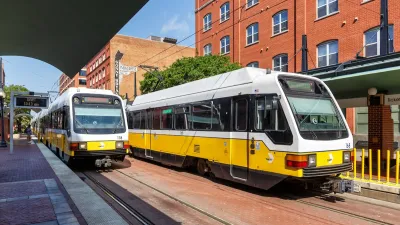A new 28-mile expansion makes the city's system is the largest in the nation, but is it actually changing travel habits? Yonah Freemark investigates.
The city of Dallas remains committed to expanding light rail transit despite discouraging ridership numbers, says Freemark. Between 2000 and 2010, the overall number of Dallas's public transit users actually declined, and only 60,000 people ride the light rail each day--a small fraction of the city's 1.3 million residents.
The problem, says Freemark, is a lack of coordination with other planning and policy areas. Although Dallas' light rail network is expansive, downtown parking policies do little to discourage driving. Freemark also argues the city currently lacks the density to support a more robust light rail network, a problem that might be solved by encouraging transit-oriented development.
Freemark writes:
"Dallas and all of the cities being served by light rail must make a more serious effort to attract new growth into the transit zones around stations. If people are going to be living in apartments anyway, have them do so in mixed-use, walkable neighborhoods within easy distance of light rail stops. If this means using eminent domain to spur private redevelopment, then so be it: Something significant must be done to encourage increased use of the transit network."
FULL STORY: An Extensive New Addition to Dallas’ Light Rail Network Makes it America’s Longest

Alabama: Trump Terminates Settlements for Black Communities Harmed By Raw Sewage
Trump deemed the landmark civil rights agreement “illegal DEI and environmental justice policy.”

Planetizen Federal Action Tracker
A weekly monitor of how Trump’s orders and actions are impacting planners and planning in America.

The 120 Year Old Tiny Home Villages That Sheltered San Francisco’s Earthquake Refugees
More than a century ago, San Francisco mobilized to house thousands of residents displaced by the 1906 earthquake. Could their strategy offer a model for the present?

In Both Crashes and Crime, Public Transportation is Far Safer than Driving
Contrary to popular assumptions, public transportation has far lower crash and crime rates than automobile travel. For safer communities, improve and encourage transit travel.

Report: Zoning Reforms Should Complement Nashville’s Ambitious Transit Plan
Without reform, restrictive zoning codes will limit the impact of the city’s planned transit expansion and could exclude some of the residents who depend on transit the most.

Judge Orders Release of Frozen IRA, IIJA Funding
The decision is a victory for environmental groups who charged that freezing funds for critical infrastructure and disaster response programs caused “real and irreparable harm” to communities.
Urban Design for Planners 1: Software Tools
This six-course series explores essential urban design concepts using open source software and equips planners with the tools they need to participate fully in the urban design process.
Planning for Universal Design
Learn the tools for implementing Universal Design in planning regulations.
Clanton & Associates, Inc.
Jessamine County Fiscal Court
Institute for Housing and Urban Development Studies (IHS)
City of Grandview
Harvard GSD Executive Education
Toledo-Lucas County Plan Commissions
Salt Lake City
NYU Wagner Graduate School of Public Service




























